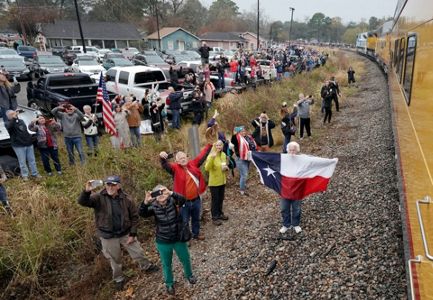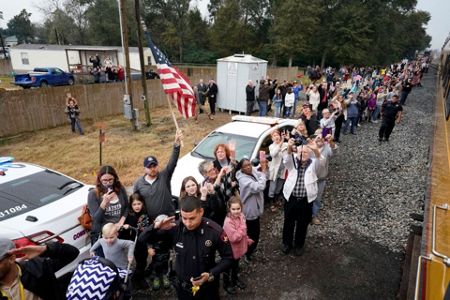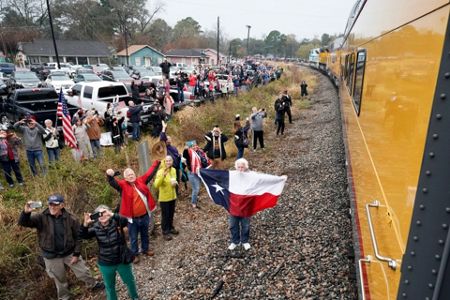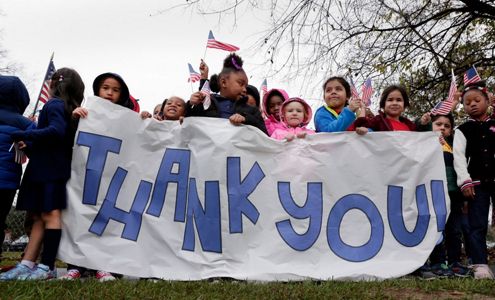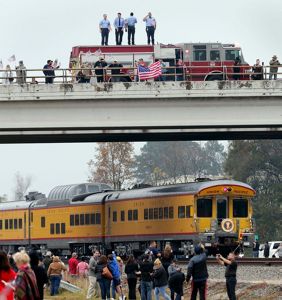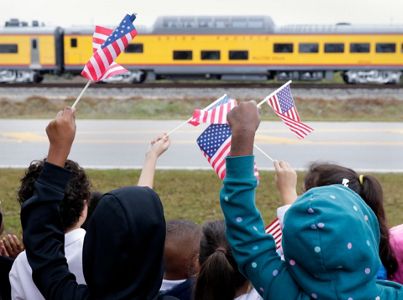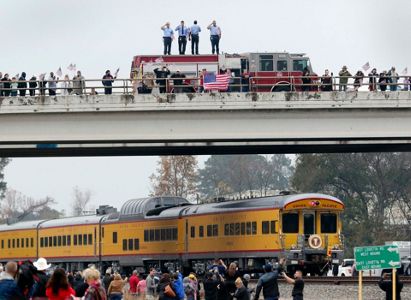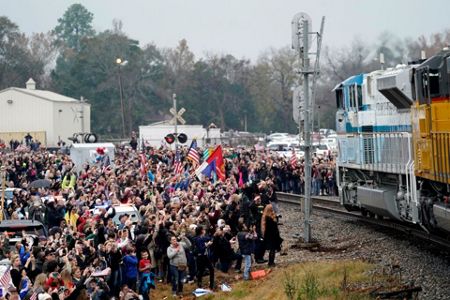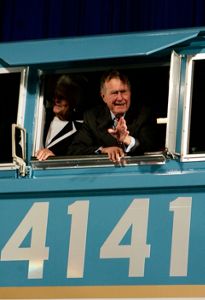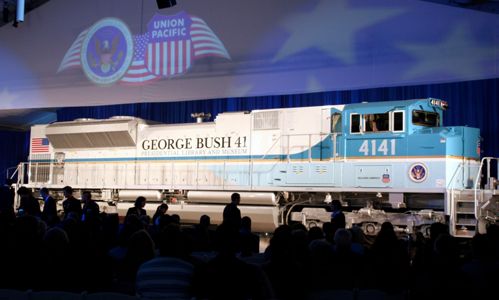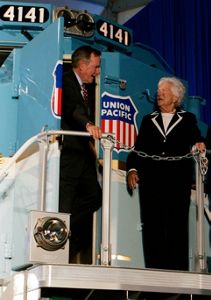SPRING, Texas (AP) — The locomotive was painted to resemble Air Force One, but George H.W. Bush joked that if it had been around during his presidency, he may have preferred to ride the rails rather than take to the skies.
"I might have left Air Force One behind," Bush quipped during the 2005 unveiling of 4141, a blue and gray locomotive commissioned in honor of the 41st president and unveiled at Texas A&M University.
On Thursday, that same 4,300-horsepower machine left a suburban Houston railyard loaded with Bush's casket for his final journey after almost a week of ceremonies in Washington and Texas. The train then embarked on a slow roll to his presidential library in College Station, passing thousands of people who stood along the tracks. Many of them held up their phones for pictures and watched from highway overpasses.
One of the first small towns to greet the train was Pinehurst, where Andy Gordon, took his 6-year-old daughter, Addison, out of school so she and her 3-year-old sister, Ashtyn, could witness the moment firsthand.
"Hopefully, my children will remember the significance and the meaning of today," said Gordon, 38. In Addison's hand were two small American flags.
At one point, state troopers hovering in a helicopter ordered people to get off the tracks as the train approached. Some onlookers left coins on the tracks to be flattened into keepsakes.
More than two hours after departing, the train rolled to a stop in College Station, where Bush was laid to rest at a private ceremony next to his wife, Barbara, who died in April, and his daughter Robin, who died at age 3 in 1953. Family members, including former President George W. Bush, were also aboard the 12-car train that was greeted by student cadets and mourners upon arriving at Texas A&M University.
The train's sixth car, a converted baggage hauler called "Council Bluffs," was fitted with transparent sides to allow the mourners lining the tracks views of Bush's flag-draped coffin. The train rolled past the flashing lights of firetrucks, some hoisting American flags from their ladders, and past state troopers who saluted from the side of the tracks.
It is the eighth presidential funeral train in U.S. history and the first since Dwight D. Eisenhower's body traveled from the National Cathedral in Washington through seven states to his Kansas hometown of Abilene 49 years ago. Abraham Lincoln's funeral train was the first, in 1865.
Robert F. Kennedy was never president, but he was running for the White House when he was assassinated in Los Angeles in 1968. His body was later transported to New York City for a funeral Mass and then taken by private train to Washington for burial at Arlington National Cemetery. Thousands of mourners lined the tracks for the 200-plus-mile journey.
Union Pacific originally commissioned the Bush locomotive for the opening of an exhibit at his library titled "Trains: Tracks of the Iron Horse." It was one of the few times the company has painted a locomotive any color other than its traditional yellow. After a brief training session during 4141's unveiling 13 years ago, Bush took the engineer's seat and helped take the locomotive for a 2-mile excursion.
"We just rode on the railroads all the time, and I've never forgotten it," Bush said at the time, recalling how he took trains, and often slept on them, during trips as a child with his family. He also called the locomotive "the Air Force One of railroads."
Bush, who died last week at his Houston home at age 94, was eulogized Wednesday at a funeral service at the National Cathedral and again Thursday at St. Martin's Episcopal Church in Houston.
The funeral train has been part of the official planning for his death for years, Bush spokesman Jim McGrath said.
Union Pacific was contacted by federal officials in early 2009 and asked, at Bush's request, about providing a funeral train at some point, company spokesman Tom Lange said.
"We said, 'Of course and also we have this locomotive that we would want to have obviously be part of it,'" Lange said. He noted that trains were the mode of transportation that first carried Bush to his service as a naval aviator in World War II and back home again.
Eisenhower was the last president to travel by train regularly. A key reason was his wife, Mamie, who hated to fly. During the 1952 campaign, Eisenhower traveled more than 51,000 miles and made 252 stops. And while he often flew, his wife rode the train the whole time, Union Pacific said.
Still, when Bush beat Democrat Michael Dukakis and won the presidency in 1988, both candidates used trains to make some campaign stops. Bush also occasionally traveled by train in 1992, when he was defeated by Democrat Bill Clinton, including making Midwest stops aboard a train dubbed "The Spirit of America."
___
Weissert reported from Austin. Associated Press Writer Nomaan Merchant in Pinehurst, Texas, also contributed to this report.
___
See AP's complete coverage of George H.W. Bush here: https://www.apnews.com/GeorgeHWBush .
Copyright 2018 The Associated Press. All rights reserved. This material may not be published, broadcast, rewritten or redistributed.






